Kaunos
Kbid olarak da bilinir.
- Tür: Antik Kent, Ören Yeri
- Tema: Arkeolojik Kazılar, UNESCO Dünya Mirası Geçici Listesi
- Kültür: Antik Yunan, Bizans, Helenistik, Karya, Roma
- Yüzyıl: MÖ 4. yy, MÖ 6. yy, MÖ 9. yy
- Bölge: Türkiye, Ege Bölgesi, Muğla, Köyceğiz
Καῦνος (in Greek) | |
 Kaunos Theater | |
| Location | Dalyan, Muğla Province, Turkey |
|---|---|
| Region | Caria |
| Coordinates | 36°49′35″N 28°37′17″E / 36.82639°N 28.62139°E |
| Type | Settlement |
| History | |
| Founded | 10th century BC |
| Abandoned | 15th century AD |
| Associated with | Protogenes, Zeno |
| Site notes | |
| Condition | Ruined |
| Ownership | Public |
| Public access | Yes |
| Website | Kaunos Archaeological Site |



Kaunos (Carian: Kbid;[1] Lycian: Xbide;[1] Ancient Greek: Καῦνος; Latin: Caunus) was a city of ancient Caria and in Anatolia, a few kilometres west of the modern town of Dalyan, Muğla Province, Turkey.
The Calbys river (now known as the Dalyan river) was the border between Caria and Lycia. Initially Kaunos was a separate state; then it became a part of Caria and later still of Lycia.
Kaunos was an important sea port, the history of which is supposed to date back to the 10th century BC. Because of the formation of İztuzu Beach and the silting of the former Bay of Dalyan (from approx. 200 BC onwards), Kaunos is now located about 8 km from the coast.[2] The city had two ports, the southern port at the southeast of Küçük Kale and the inner port at its northwest (the present Sülüklü Göl, Lake of the Leeches). The southern port was used from the foundation of the city till roughly the end of the Hellenistic era, after which it became inaccessible due to its drying out. The inner or trade port could be closed by chains. The latter was used till the late days of Kaunos,[3] but due to the silting of the delta and the ports, Kaunos had by then long lost its important function as a trade port. After the capture of Caria by Turkish tribes, and the serious malaria epidemic of the 15th century AD, Kaunos was completely abandoned.
In 1966, Prof. Baki Öğün started the excavations of ancient Kaunos. These have been continued up to the present day, and are now supervised by Prof. Cengiz Işık.
The archeological research is not limited to Kaunos itself, but is also carried out in locations nearby e.g. near the Sultaniye Spa where there used to be a sanctuary devoted to the goddess Leto.[4]
- ^ a b Adiego, I.J. (2007). "Greek and Carian". In Christidis, A.F.; Arapopoulou, Maria; Chriti, Maria (eds.). A History of Ancient Greek From the Beginning to Late Antiquity. Chris Markham (trans.). Cambridge University press. p. 762. ISBN 978-0-521-83307-3.. Translator Chris Markham.
- ^ Köyceğiz-Dalyan, a journey through history within the labyrinth of nature; Altan Türe; 2011; Faya Kültür Yayınları-1; ISBN 978-978-978-605-3
- ^ Dalyan 2005 Gezi Kitabı/Travel book; Fatih Akaslan; ISBN 975-270-471-9
- ^ History surfaces from Köyceğiz Lake, Land of Lights, October 28th, 2010
✶ İlgili Yerler
- Kaunos Antik Tiyatrosu
- Kaunos Liman Agorası
- Kaunos Nymphaeum
- Kaunos Roma Hamamı
- Kaunos Kubbeli Bazilika
- Kaunos Teras Tapınağı
- Kaunos Kaya Mezarları
- Kaunos Akropolis
- Kaunos Monopteros
- Kaunos Ölçüm Platformu
- Kaunos Dionysos Tapınağı
- Kaunos Apollon Kutsal Alanı
- Kaunos Demeter Kutsal Alanı
- Kaunos Tuzlası
- Kaunos Liman Bazilikası
- Kaunos Quintus Vedius Capito ve Glykinna Anıtları
- Kaunos Tiyatro Çeşmesi
- Kaunos Korint Tapınak
- Kaunos Kaya Mezarı
- Kasparyanda?
- Kaunos Şehir Surları
- Kaunos Eski Liman
✶ Kaynaklar

